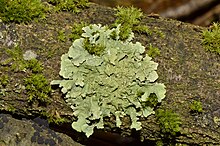

A foliose lichen is a lichen with flat, leaf-like lobes, which are generally not firmly bonded to the substrate on which it grows. It is one of the three most common growth forms of lichens. It typically has distinct upper and lower surfaces, each of which is usually covered with a cortex; some, however, lack a lower cortex.[1][2] The photobiont layer lies just below the upper cortex.[2] Where present, the lower cortex is usually dark (sometimes even black), but occasionally white.[2] Foliose lichens are attached to their substrate either by hyphae extending from the cortex or medulla, or by root-like structures called rhizines.[3] The latter, which are found only in foliose lichens, come in a variety of shapes, the specifics of which can aid in species identification.[4] Some foliose lichens attach only at a single stout peg called a holdfast, typically located near the lichen's centre. Lichens with this structure are called "umbilicate".[3] In general, medium to large epiphytic foliose lichens are moderately sensitive to air pollution, while smaller or ground-dwelling foliose lichens are more tolerant.[5] The term "foliose" derives from the Latin word foliosus, meaning "leafy".[6]
- ^ Baron 1999, p. 27.
- ^ a b c Brodo, Sharnoff & Sharnoff 2001, p. 13.
- ^ a b Brodo, Sharnoff & Sharnoff 2001, p. 14.
- ^ Brodo, Sharnoff & Sharnoff 2001, pp. 13–14.
- ^ United States Forest Service.
- ^ Ulloa & Hanlin 2012, p. 229.